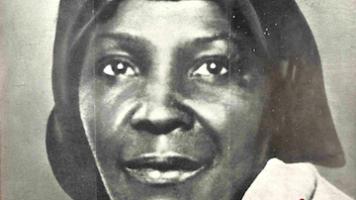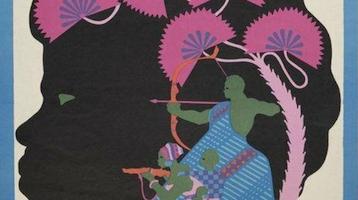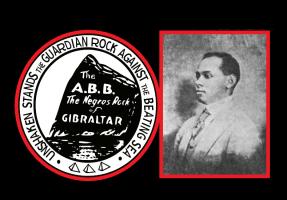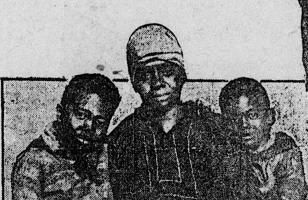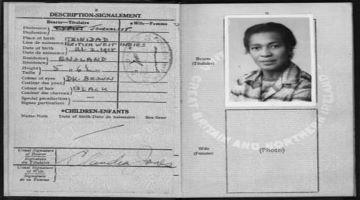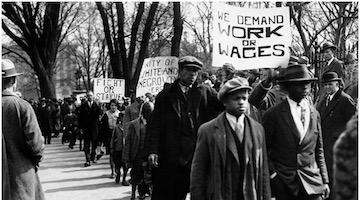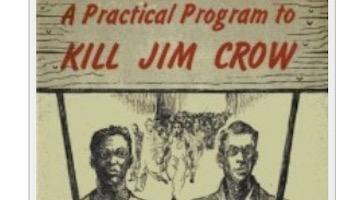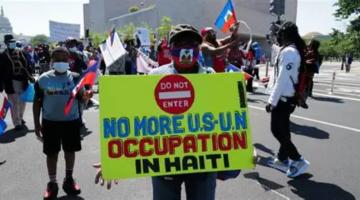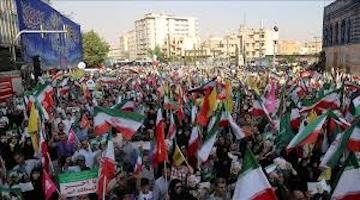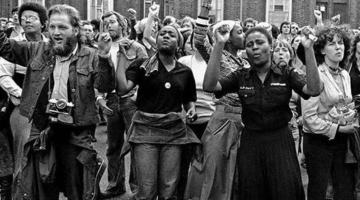On the 153th anniversary of the birth of Vladimir Lenin, we present Harry Haywood’s theoretical work on imperialism, capitalism, and Black self-determination which emphasizes the importance of Lenin to Black class struggle.
Harry Haywood was born in South Omaha, Nebraska in 1898 to formerly enslaved Africans hailing from Missouri and West Tennessee. Influenced by his older brother Otto, and by his teenage reading of Vladimir Lenin’s The State and Revolution, Haywood joined the African Black Brotherhood in 1922 and the Communist Party, USA in 1925. In 1927, Haywood went to study at the Communist University of the Toilers of the East and the International Lenin School where he met figures like Ho Chi Minh.
While in Moscow, Haywood began to apply Lenin’s theories of colonialism, nationalism, and self-determination to the status and conditions of African Americans. The result was the “Comintern Resolutions on the Negro Question" of 1928 and 1930, and the assertion that Black Americans in the US South were a “nation within a nation” whose experiences were similar to that of other colonial peoples. Haywood argued for the creation of an autonomous “Black Belt Republic” that could serve as a platform to conjoin the class struggle of Black folks with the struggles of other nations fighting against capitalism, colonialism, and imperialism.
Haywood’s position was controversial, challenged by fellow Communists and contested by figures like CLR James.. Yet even beyond both his expulsion from the Communist Party in the late 1950s (after the party dropped their commitment to Black self-determination), and his death in 1988, Haywood’s writings have long served as a platform for discussion of a Black nationalist struggle that was not reducible to race, and an anticapitalist struggle that was not reducible to class. And it points to the enduring importance of the work of Lenin within the history of Black thought and politics. For more, readers should turn to Haywood’s magnificent autobiography, Black Bolshevik: Autobiography of an Afro-American Communist, and to the essay reproduced below: “The Struggle for the Leninist Position on the Negro Question in the United States.” (An abbreviated version of an essay that first appeared in 1933 in The Communist.)
The Struggle for the Leninist Position on the Negro Question in the United States
Harry Haywood
The present program of our Party on the Negro question was first formulated at the Sixth Congress of the Communist International, in 1928. On the basis of the most exhaustive consideration of all the peculiarities, historical development, economic, living and cultural conditions of the Negro people in the United States as well as the experience of the Party in its work among Negroes, that Congress definitely established the problem of the Negroes as that of an oppressed nation among whom there existed all the requisites for a national revolutionary movement against American imperialism.
This estimation was a concrete application of the Marxist-Leninist conception of the national question to the conditions of the Negroes and was predicated upon the following premises: first, the concentration of large masses of Negroes in the agricultural regions of the Black Belt, where they constitute a majority of the population; secondly, the existence of powerful relics of the former chattel slave system in the exploitation of the Negro toilers — the plantation system based on sharecropping, landlord supervision of crops, debt slavery, etc.; thirdly, the development, on the basis of these slave remnants, of a political superstructure of inequality expressed in all forms of social proscription and segregation; denial of civil rights, right to franchise, to hold public offices, to sit on juries, as well as in the laws and customs of the South. This vicious system is supported by all forms of arbitrary violence, the most vicious being the peculiar American institution of lynching. All of this finds its theoretical justification in the imperialist ruling class theory of the "natural" inferiority of the Negro people.
This whole vicious system of oppression, while being most sharply felt by the Negro masses in the South also affects their social status in the rest of the country. The Negro poor farmers and farm laborers fleeing from the misery and starvation of the Southern plantations to the industrial centers of the North, do not thereby obtain freedom. On the contrary, at their heels follows also the heritage of plantation slavery resulting in lower wages, worse living conditions, discrimination in social life even in the "liberal" North. Thus agrarian revolution, i.e. the struggle of the poverty-stricken and land-starved Negro sharecroppers and poor farmers on the Black Belt and in the South for the land, for the destruction of all vestiges of slave bondage — this, together with the general struggle for democratic rights of the Negro people all over the country, as well as for their rights to independent national existence on the Black Belt, constitute the chief axis of the Negro national liberation movement in the U.S.A.
The enslavement of the Negro masses in the United States is an important prop of American imperialism. American imperialism is fundamentally interested in the preservation of the slave remnants in Southern agriculture and the national oppression of the Negro people as a condition for the extraction of super profits. It is the force that stands behind the Southern white ruling classes (capitalists and landlords) in their direct and violent plunder of the Negro masses in the Black Belt. Therefore, the liberation struggles of the Negro masses are directed against the very foundation of the capitalist-imperialist social structure in the United States.
In the present epoch of imperialism and proletarian revolution the Negro question in the United States must be considered as part of the national colonial problem, or, in other words, it is part of the general world-wide problem of freedom of the oppressed and dependent peoples from the shackles of imperialism…
The Negro masses, once the allies of the Northern bourgeoisie (during the Civil War and Reconstruction), have now become the allies of the proletariat. In their struggle for national liberation these masses constitute an important part of the army of the revolutionary proletariat in the struggle for the overthrow of American capitalism. Hence, the victory of the proletarian revolution in the United States and the struggle of the Negro masses for national liberation demand the consummation of a united fighting front of the white toilers and the Negro people against the common enemy, — American imperialism. Such a united front can only be effective on the basis of direct and effective support by the white working class (as the working class of the oppressor nation) to the efforts of the Negro masses to free themselves from the imperialist yoke. In this connection it is important to keep in mind the dictum of Karl Marx to the English working class on the Irish question: "A people which oppresses another people cannot itself be free."…
The first real achievements of our Party in the leadership of the Negro masses date from the beginning of the application of this Leninist line. A historical landmark in the development of our Negro work was the public trial of August Yokinen. In this trial the case of discrimination by a white Party member against Negroes was made the occasion for a political demonstration in which the Party's program on the Negro question and the struggle against white chauvinism were dramatized with an unprecedented effect before the widest masses throughout the country. Comrade Browder in his report before American students, in estimating the political significance of this trial, declared "that it was a public challenge dramatically flung into the face of one of the basic principles of social relationships in Americ — the American institution of Jim-Crowism… The expulsion of Yokinen, expressing our declaration of war against white chauvinism, exerted a tremendous influence to draw the Negro masses closer to us."
In this trial the Party achieved a great step forward in the education of its membership and the masses around the Party on our program on the Negro question. This was particularly exemplified in Comrade Yokinen himself who, after six months, came back into the Party as one of the staunchest fighters for its program of Negro liberation and who, as a result of his courageous and militant stand on this question, was deported by the Negro-hating imperialist government. The trial of Yokinen served to prepare the Party ideologically for a real interest in the struggle for Negro rights.
The Yokinen trial was immediately followed by the organization of a mass movement to save the lives of the Scottsboro boys. On the basis of the political preparation through the Yokenin trial the Party was able to seize effectively upon the issue of the frame-up of these boys to develop a tremendous campaign of mass action and the exposure of the whole system of national oppression of the Negroes. The Scottsboro campaign marked the first real nation-wide mobilization of masses by the Party of concrete struggle against one of the cornerstones of capitalist Negro oppression — the institution of lynching. Through the struggle on this issue the Party was able to bring its program before the widest masses of Negro and white toilers, arousing among them the greatest sympathy and confidence. Scottsboro, as the first big battle conducted by the Party on the front of Negro national liberation, did much to break down the traditional barriers of chauvinism and national distrust separating the Negro and white toilers. This struggle, which was coupled with a real political exposure of the treacherous role of the Negro bourgeois reformists of the N.A.A.C.P., hastened the process of class differentiation among the Negroes — the separation of the interests of the Negro proletarian and semi-proletarian masses from the general interests of "race-solidarity" as propagated by the Negro bourgeois nationalists. The Negro toilers began to understand class divisions. They began to find out who were their friends and who their enemies.
Only through the vigorous application of our correct Leninist program on the Negro question could the Party carry through and lead such a struggle as the Scottsboro campaign. This campaign gave rise to the sudden movement of mass participation of Negro workers on an unprecedented scale in the general struggles of the working class throughout the country. The great strike of the Pennsylvania, Ohio and West Virginia coal miners which broke out in 1931, during the first part of the Scottsboro campaign, witnessed greater participation of Negro workers than any other economic action led by revolutionary trade unions. Large masses of Negro workers rallied to the unemployed movement, displaying matchless militancy in the actions of the unemployed. Notable examples of this were the heroic demonstrations against evictions in the Negro neighborhoods of Chicago and Cleveland.
While the Negro masses were beginning to participate more more and the class struggles in the North, an event of great historical significance occurred in the Black Belt — the organization of the Sharecroppers Union and the heroic resistance of the sharecroppers to the attacks of the landlords and sheriffs at Camp Hill, Alabama. In this struggle the revolutionary ferment of the Negro poor farmers and sharecroppers received its first expression, resulting in the establishment of the first genuine revolutionary organization among the Negro poor farmers — the militant Sharecroppers Union. The agrarian movement of the Negro masses was further continued and developed in the Tallapoosa fight in which the sharecroppers gave armed resistance to the legalized robbery of the landlords and merchants.
This whole series of class and national liberation struggles was further deepened and politicized through the Communist presidential election campaign of 1932. In this campaign the Party was able to further extend its program among the masses, rally large numbers of Negroes behind its political slogans.
Thus the application of a Bolshevik program in conditions of sharpening crisis and growing radicalization of the Negroes has resulted in the extension of the political influence of the Party among the broad masses of Negroes, and in the growth of Party membership among them. Of outstanding importance in this period is the establishment of the Party in the South and in the Black Belt.
These struggles have led to a growing class consciousness of the Negro working class and its emergence upon the political arena as an independent class force in the Negro liberation movement. In the course of these struggles the Negro working class is rapidly liberating itself from the treacherous reformist influences. Thus the characteristic of the present stage of development of the Negro movement is the maturing of this most important driving force of Negro liberation — the Negro industrial working class. The Negro workers, in close organic unity with the white working class and under the leadership of the Communist Party is the only force capable of rallying the masses of Negro toilers in a victorious struggle against capitalism. The struggle for Negro liberation is now taking place under conditions of growing proletarian hegemony and Communist Party leadership—
The emphasis upon the development of economic struggles among the Negro toilers does not mean to slacken but on the contrary to increase in every way the struggle around general issues of Negro liberation, such as Scottsboro and the fight against lynching. It is necessary to broaden out and deepen these struggles, bringing forward our full program of social equality and right of self-determination and building the broadest united front on these issues. Our chief task, however, is to bring this struggle into the shops and factories and on the land, linking it up with the more immediate demands of the Negro toilers, making the factories the main base in the struggle of Negro liberation and our trade unions the main lever for the organization of the Negro working class. At the same time the revolutionary mass organizations and particularly the trade unions must come forward more energetically in the struggle on behalf of the political demands of the Negro toilers.
This must go hand in hand with the ruthless combating of all forms of chauvinist and Jim Crow practices and the patient, systematic but persistent struggle against the ideology and influences of petty-bourgeois nationalists among the Negro toilers.
Only on this basis will the Party be able to give leadership to the rapidly developing upsurge of the Negro masses and to build this movement into a powerful movement of the revolutionary proletariat for the weakening and destruction of the rule of American imperialism.
Harry Haywood, “The Struggle for the Leninist Position on the Negro Question in the United States,” The Communist (September, 1933). This essay was reprinted from “Marxists Internet Archive.” The following note appeared on the original: “This article by Harry Haywood, originally printed in the September 1933 issue of the The Communist, is from A Documentary History of the Negro People in the United States, edited by Herbert Aptheker. According to the editor, the original article "is published below, in part, with the essential argumentation intact.”

